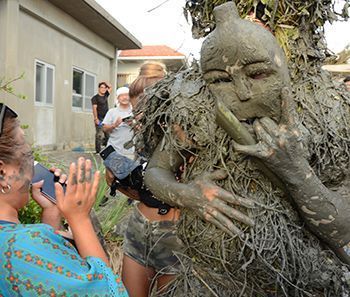Okinawan traditional Miyakojima Pantu being considered for UNESCO intangible cultural heritage status

Pantu being practiced in Hirara Shimajiri, Miyakojima City, which is nominated for intangible cultural heritage status with a subsidiary organization of UNESCO.
October 25, 2018 Ryukyu Shimpo
On October 24 Japan’s Agency for Cultural Affairs announced that it has nominated ten traditional practices from eight prefectures of Japan that involve wearing masks or costumes to represent deities, including “Pantu” in Miyakojima and “Oga no Namahage” in Akita, to a subsidiary organization of the United Nations Educational Scientific and Cultural Organization (UNESCO) for intangible cultural heritage designation.
UNESCO’s Intergovernmental Committee will meet on Mauritius Island in the Indian Ocean between November 26 and December 1, when the nominated events will likely be incorporated onto the intangible cultural heritage list. Kumiodori, an Okinawan dance style, was granted UNESCO intangible cultural heritage status in November 2010.
If the deity practices are designated this time around, it will be the second instance of Okinawan practices gaining this status.
This is an opportunity for Okinawa to gain global recognition for its precious intangible cultural heritage.
Visiting deity practices are performed at times like the New Year.
In these practices people dress up in masks and costumes to represent deities, walk from house to house and spread joy.
The ten items up for UNESCO designation are already designated as important intangible folk culture assets by Japan, including Miyakojima Pantu practiced in Hirara Shimajiri and Nobaru Ueno in Miyakojima City.
In March last year the Japanese government submitted an application for Pantu for intangible cultural heritage status, because it is a tradition rooted in the region that serves to strengthen community ties, passed down over generations.
According to the Agency for Cultural Affairs, the UNESCO subsidiary organization expressed that it values visiting deity practices, as they demonstrate regional cultural diversity, and is taking steps to protect them.
One of the ten practices being considered is Kagoshima Prefecture’s “Toshidon of Koshiki Island,” which already gained intangible cultural heritage status indiviudually in 2009.
After that, the Japanese government decided to nominate other practices to join the intangible cultural heritage list as a conglomerate item with Toshidon as “visiting deity practices.”
The ten items include Kagoshima’s Namahage, which is similar to Toshidon, and Miyakojima Pantu.
Japan currently has 21 items designated for intangible cultural heritage status.
Since Toshidon has already been designated, other visiting deity practices will be seen as an extension with Toshidon, so even if the practices are incorporated, Japan’s number of items listed on the intangible cultural heritage list will technically not increase.
(English translation by T&CT and Erin Jones)
Previous Article:Agency for Cultural Affairs announces 2018’s winners for the ACA Film Awards
Next Article:The Global Community Center Connects Egypt to the Hantagawa Community Center in Naha
[Similar Articles]
- Pantu in Miyako to be Nominated for UNESCO Intangible Cultural Heritage
- Symposium aiming to add Okinawa Karate to UNESCO’s Intangible Cultural Heritage list
- Effort to add Ryukyu cuisine and Awamori to UNESCO Intangible Cultural Heritage list picks up steam as official statement is adopted at rally in Naha
- Calling out Hoi to ward off evil spirits ― Satiparo held in Miyakojima
- OCVB to host committee aimed at adding Ryukyu cuisine and awamori to UNESCO’s list of intangible heritage list
 Webcam(Kokusai Street)
Webcam(Kokusai Street)


